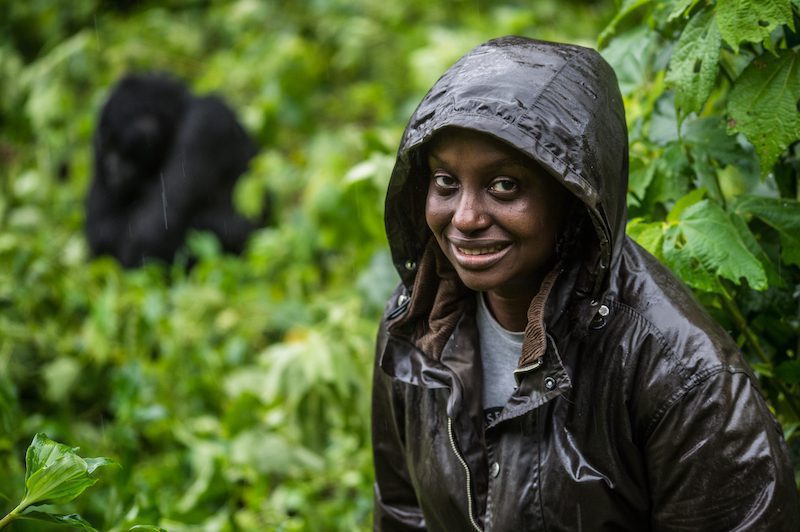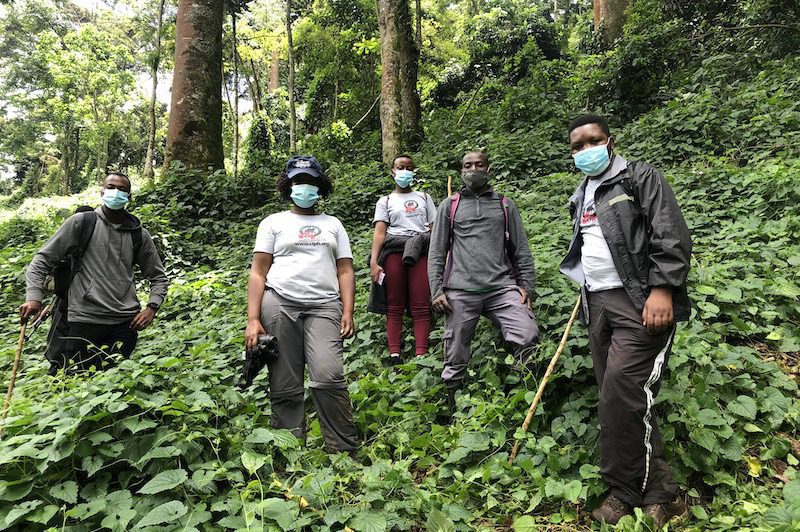Last updated on November 19th, 2023
Featured image: Adult black back gorilla in Bwindi Impenetrable National Park | Photo by Jo Anne McArthur
Uganda’s famed veterinarian on her journey with the mountain gorillas
By Rupi Mangat, Contributor, Women in Africa
2023 is a special year for Conservation Through Public Health (CTPH), founded by Ugandan veterinarian Dr. Gladys Kalema-Zikusoka, Uganda’s first wildlife vet and the recipient of global awards for her work in mountain gorilla conservation.
This year celebrates CTPH’s 20th anniversary to save mountain gorillas in Uganda, living in the dense forests of Bwindi Impenetrable Forest, in partnership with the communities living alongside. Today, Bwindi’s population of Mountain gorillas is increasing, and the mountain gorilla is listed as Endangered on The International Union for Conservation of Nature’s Red List of Threatened Species (IUCN) Red List, up from Critically. (Established in 1964, The IUCN’s Red List of Threatened Species has evolved to become the world’s most comprehensive information source on the global conservation status of animal, fungi and plant species.)
A journey that began 30 years ago
With a youthful aura at 53, Kalema-Zikusoka charms her visitors with her passion for the great ape, a journey that began 30 years ago.
“After graduating as a veterinary doctor, my first assignment was to set up the veterinary unit at the Uganda Wildlife Authority (UWA) in 1996,” she relates sitting in her office in Entebbe on the shores of Lake Victoria, Africa’s largest freshwater lake shared by the three East African countries – Uganda, Kenya and Tanzania.

Dr Gladys Kalema-Zikusoka / Photo by UNEP – Kibuuka Mukisa
It was here that she had her first encounter with the mountain gorillas in Uganda, ‘discovered’ only in the 1980s in Bwindi.
“The locals knew about the gorillas, but the outside world did not. It’s only when researchers found their scat and did genetic analysis, that it came to light that there were mountain gorillas in Uganda,” Kalema-Zikusoka says. At the time Uganda was in the midst of political turmoil, so the discovery made little headlines.
With peace restored in Uganda and neighbouring Rwanda, gorilla tourism took root.
“In 1994, there were two groups in Bwindi habituated to humans and it was a very exciting time because the local people living around the forest saw the gorillas lifting them out of poverty as gorilla tourism had just began,” continues the soft-spoken woman.
At the time there were only about 300 mountain gorillas in Bwindi.
But it coincided with one group of four gorillas contracting scabies.
“This was the first disease outbreak we discovered at the UWA,” she says.
The group – a family of the dominant male Silverback, the female, one juvenile and an infant – was used to raiding the farms on the edge of the forest.
“They saw the fields as their forest before it was converted into farmland,” explains Kalema-Zikusoka, bringing the situation into perspective.
The farmers erected scarecrows dressed in their discarded clothes.
This is when the young veterinarian made the connection between the discarded clothes full of scabies-causing mites and the outbreak of scabies in the gorilla family. Humans have built a resistance to scabies but the gorillas have not.
This was to change her life.
Food for All
CTPH partners with more than 50 mountain villages, reaching out to 7,000 households that translate to 35,000 people and increasing.
A recent project is on food security. CTPH provides fast-growing vegetable and fruit seedlings to 1,500 households, working with agronomists to provide advice on organic farming that does not destroy the soil. The seedlings are continually harvested for the next season’s planting.
“When people do not have enough to eat, they will poach as we saw during the Covid pandemic when there was no money coming in through tourism,” she states.
Laying snares to trap wildlife, referred to as ‘bushmeat trade’ is unfortunately rife in Africa. Sometimes, the gorillas get caught in the snares as innocent victims – most often losing a limb. CTPH has donated more than 60 camera traps to the UWA to support the anti-poaching unit and the rangers who patrol the park for snares. Since then, there’s been no gorilla killed in a snare.
In the few cases where gorillas have been killed by poachers, sentences are increasingly becoming severe as local magistrates are trained on wildlife laws, something CTPH advocated for. In a recent case, a poacher was jailed 11 years for spearing a gorilla to death. In previous years, the sentence was as little as a few dollars, hardly a deterrent to the poacher.
Healthy Lives
Engaging with a group of volunteer community health workers called the Village Health and Conservation team, the villagers have access to education and health-care centres where there is treatment for scabies, HIV/Aids and family planning.
“We call this the Behaviour Change Communication (BCC) talking about being healthy, the importance of hygiene and the benefits of family planning and budgeting,” explains the gorilla crusader. “The women like it because it gives them more control over their bodies and health,” states Kalema-Zikusoka.

Dr Gladys Kalema-Zikusoka tracking gorillas in Bwindi Impenetrable National Park / Photo by Jo Anne McArthur

CTPH team monitoring Mubare Gorilla Group in September 2020 / Photo by CTPH
One of the most interesting things that she has learnt from the female gorillas is that they give birth once every four to five years because the female gorilla breastfeeds her baby for three years which humans should also do. It’s practicing family planning naturally.
“It’s called lactational anoestrus. You can’t get pregnant if you breastfeed your baby exclusively on breast milk. Wild animals are able to because they don’t have supplements. I spaced our two boys like the gorillas did, four and a half years apart.”
Gorilla Coffee
Partnering with 500 rural coffee farmers around Bwindi, CTPH’s branded coffee is Kanyonyi, who was Kalema-Zikusoka’s favourite gorilla. A picture of his face is on each package. The high-grade Arabica is sold in the U.S., the U.K., and several European countries including online, earning the local farmers higher income under the fair trade market.
Kanyonyi was the gorilla she fell in love with after operating on his older sister when she had a rectal prolapse.
“He was very friendly and everybody liked him,” she recalls. He died in 2017 at age 21 from injuries caused from falling off a tree and breaking his hip. In his weakened state, he was attacked by a younger male, taking control of the group.
Coffee also yields higher returns than tea because farmers can inter-crop vegetables and fruits between the coffee.
Future Forests
Today Bwindi’s population of mountain gorillas is 459 and increasing. The global population (found only in Bwindi and the Virunga mountains straddling Rwanda and the Democratic Republic of Congo) is 1,063. In the 1980s, the known population in the Virungas was 240. The Mountain gorilla is now listed Endangered on the IUCN Red List from Critically endangered, meaning one step away from becoming extinct in the wild.
With the gorilla population increasing and the land remaining static, CTPH’s new project is buying unused land from the rural farmers to increase space for the gorillas. It’s an on-going engagement where the villagers are counselled on family planning and re-investing the money to become self-sufficient and provide education for children.
“Big families means many mouths to feed, increasing land wrangles and forest fragmentation,” she states.

Dr. Gladys with women VHCTs living around Bwindi Impenetrable National Park / Photo by CTPH
Big win: In July 2022, at the International Union of Conservation (IUCN) meeting in Rwanda, CTPH presented a policy brief with International Gorilla Conservation Programme and the Africa CSO Biodiversity Alliance on responsible great ape tourism which was adopted, laying the protocol for gorilla tourism in the wake of the Covid pandemic to ensure the lives of both the ape and the human.
Do you know? The dominant male Silverback thinks he is the only one who can mate with the females in his group. Gladys and her team have witnessed that extra-marital affairs are quite the norm. “Females will mate with the younger males when the dominant male is not looking,” she laughs. “When he appears, the ‘cheating’ couple immediately stops and behaves as if nothing happened. When we do the genetics, we see different daddies.”
Read: Walking with Gorillas by Gladys, available here.
Meet Dr. Gladys at an upcoming book launch event in April – June.
Wildlife and safaris to see mountain gorillas in Uganda
Contact: Dr. Gladys Kalema-Zikusoka on [email protected] and Kaniwabo Elizabeth on [email protected]
Find a women-friendly tour to Uganda on the Women’s Travel Directory here!
More Inspiring Stories From Africa
Why Women Should Visit Nairobi, Kenya (From a Local)
Kenyan Rupi Mangat says her home of Nairobi, Africa has much to offer women over 50, because it’s modern, cosmopolitan and vibrant.
10 Women-Friendly Places to Stay in Cape Town, South Africa (From Women Who Live There)
Recommended places to stay in Cape Town South Africa, from our Women’s Travel Directory, including boutique, luxury and well-known hotels.
JourneyWoman Webinar Series: Less-Travelled Africa for Women With Experts
Join our April 23 webinar to learn more about where to go in Africa, featured on our “30 Less-Travelled Places for Women to Travel in 2024.”






Gladys is the real thing. Part scholar, part warrior, part teacher and part healer, and all woman! I met Gladys at a Wildlife conference in the San Francisco Bay area and was blown away by her courage. She is an example of how one person can indeed make a difference. I can’t wait to travel to meet her again, her community, and the Gorillas in Uganda.